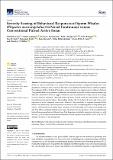Files in this item
Severity scoring of behavioral responses of sperm whales (Physeter macrocephalus) to novel continuous versus conventional pulsed active sonar
Item metadata
| dc.contributor.author | Curé, Charlotte | |
| dc.contributor.author | Isojunno, Saana | |
| dc.contributor.author | Siemensma, Marije J. | |
| dc.contributor.author | Wensveen, Paul | |
| dc.contributor.author | Buisson, Célia | |
| dc.contributor.author | Sivle, Lise D. | |
| dc.contributor.author | Benti, Benjamin | |
| dc.contributor.author | Roland, Rune | |
| dc.contributor.author | Kvadscheim, Petter H. | |
| dc.contributor.author | Lam, Frans-Peter A. | |
| dc.contributor.author | Miller, Patrick James | |
| dc.date.accessioned | 2021-04-20T10:30:05Z | |
| dc.date.available | 2021-04-20T10:30:05Z | |
| dc.date.issued | 2021-04-19 | |
| dc.identifier | 273819130 | |
| dc.identifier | 1ae3a16c-a8f7-41fa-8449-3328dab6f48f | |
| dc.identifier | 85105002070 | |
| dc.identifier | 000643103800001 | |
| dc.identifier.citation | Curé , C , Isojunno , S , Siemensma , M J , Wensveen , P , Buisson , C , Sivle , L D , Benti , B , Roland , R , Kvadscheim , P H , Lam , F-P A & Miller , P J 2021 , ' Severity scoring of behavioral responses of sperm whales ( Physeter macrocephalus ) to novel continuous versus conventional pulsed active sonar ' , Journal of Marine Science and Engineering , vol. 9 , no. 4 , 444 . https://doi.org/10.3390/jmse9040444 | en |
| dc.identifier.issn | 2077-1312 | |
| dc.identifier.other | ORCID: /0000-0002-2212-2135/work/92775113 | |
| dc.identifier.uri | https://hdl.handle.net/10023/23062 | |
| dc.description | Funding: This research was funded by four naval organizations: the US Navy Living Marine Resources program (LMR), the Netherlands Ministry of Defence, the UK Ministry of Defense (Dstl) and the French Ministry of Defense (DGA-TN). | en |
| dc.description.abstract | Controlled exposure experiments (CEEs) have demonstrated that naval pulsed active sonar (PAS) can induce costly behavioral responses in cetaceans similar to antipredator responses. New generation continuous active sonars (CAS) emit lower amplitude levels but more continuous signals. We conducted CEEs with PAS, CAS and no-sonar control on free-ranging sperm whales in Norway. Two panels blind to experimental conditions concurrently inspected acoustic-and-movement-tag data and visual observations of tagged whales and used an established severity scale (0–9) to assign scores to putative responses. Only half of the exposures elicited a response, indicating overall low responsiveness in sperm whales. Responding whales (10 of 12) showed more, and more severe responses to sonar compared to no-sonar. Moreover, the probability of response increased when whales were previously exposed to presence of predatory and/or competing killer or long-finned pilot whales. Various behavioral change types occurred over a broad range of severities (1–6) during CAS and PAS. When combining all behavioral types, the proportion of responses to CAS was significantly higher than no-sonar but not different from PAS. Responses potentially impacting vital rates i.e., with severity ≥4, were initiated at received cumulative sound exposure levels (dB re 1 μPa2 s) of 137–177 during CAS and 143–181 during PAS. | |
| dc.format.extent | 25 | |
| dc.format.extent | 5953887 | |
| dc.language.iso | eng | |
| dc.relation.ispartof | Journal of Marine Science and Engineering | en |
| dc.subject | Behavioral response study | en |
| dc.subject | Severity scoring of responses | en |
| dc.subject | Controlled exposure experiments | en |
| dc.subject | Cetceans | en |
| dc.subject | Physeter macrocephalus | en |
| dc.subject | GC Oceanography | en |
| dc.subject | QH301 Biology | en |
| dc.subject | 3rd-DAS | en |
| dc.subject.lcc | GC | en |
| dc.subject.lcc | QH301 | en |
| dc.title | Severity scoring of behavioral responses of sperm whales (Physeter macrocephalus) to novel continuous versus conventional pulsed active sonar | en |
| dc.type | Journal article | en |
| dc.contributor.institution | University of St Andrews. Sea Mammal Research Unit | en |
| dc.contributor.institution | University of St Andrews. School of Biology | en |
| dc.contributor.institution | University of St Andrews. Scottish Oceans Institute | en |
| dc.contributor.institution | University of St Andrews. Marine Alliance for Science & Technology Scotland | en |
| dc.contributor.institution | University of St Andrews. Institute of Behavioural and Neural Sciences | en |
| dc.contributor.institution | University of St Andrews. Centre for Social Learning & Cognitive Evolution | en |
| dc.contributor.institution | University of St Andrews. Bioacoustics group | en |
| dc.contributor.institution | University of St Andrews. Centre for Research into Ecological & Environmental Modelling | en |
| dc.identifier.doi | 10.3390/jmse9040444 | |
| dc.description.status | Peer reviewed | en |
| dc.identifier.url | https://www.mdpi.com/2077-1312/9/4/444 | en |
This item appears in the following Collection(s)
Items in the St Andrews Research Repository are protected by copyright, with all rights reserved, unless otherwise indicated.

